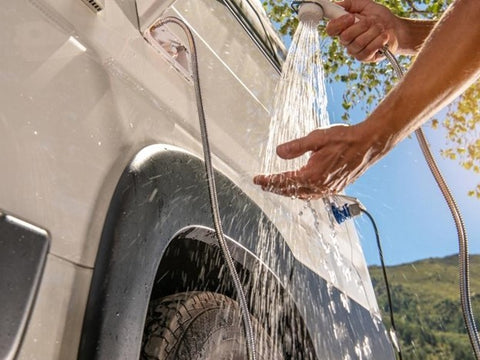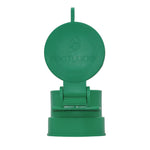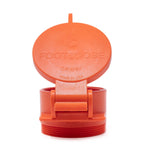You have no items in your shopping cart.
Your RV is a self-contained home on wheels. If the vehicle is equipped with water utilities of any kind, it will also have a 12-volt pump that distributes water through the system.
That pump ensures that water runs smoothly whenever you wash your hands, take a shower, or use the kitchen. The pump periodically requires maintenance, as mineral buildup can reduce the amount of water pressure in your system. Leaks and other issues can also create problems you’ll have to address quickly.
If you’ve just performed RV maintenance on your water pump, you will have to prime the pump before it starts working again. Priming is the process of getting water into the pump so that it can carry out the rest of the pumping process on its own.
How to Tell If You Need to Prime Your Water Pump
Water pumps are designed to work smoothly with a small amount of water pressure inside the pump. If there is no water, the pump can’t use the pressure gradient to push water from your reservoir to your sink. Learning how to prime a water pump is critical for any RV owner.
After you repair or replace your RV water pump, there won’t be any water in the chamber. If you try to turn it on at this point, it simply won’t pump water. That means you need to prime your water pump. You may also need to prime your water pump when winterizing your RV and then in the spring as well. This is a two-person job, so have a friend or family member available before you begin.
Preparation: How to Find your RV Water Pump
Your RV water pump should turn on whenever someone opens a faucet inside the RV. To prime the pump, you need to add water to it while the pump is on. Before you can do this, you’ll need to find your water pump and prepare the necessary materials. You’ll need a supply of water, a screwdriver, a funnel, and a clean hose.
There is no single standard location for the RV water pump. Some manufacturers place the pump underneath one of the beds. Others put the pump in the kitchen cabinet. In some cases, it’s located under one of the vehicle’s sofa seats. In general, the pump will be located less than a few feet from your RV’s fresh water tank. The owner’s manual should include a diagram showing exactly where it is.

How to Prime an RV Water Pump
To prime the pump, follow these step-by-step instructions:
- First, you’ll need to disconnect your pump from your RV’s fresh water tank or the city line.
- Ask your partner to stand inside the RV and turn on a faucet. While it’s running, use the funnel to slowly pour water directly into the pump. Water should gradually start flowing out of the faucet.
- Once this happens, turn off the pump, close the faucet, and re-attach the RV’s water intake line to the fresh water tank or the local supply line.
- Turn the supply on to ensure water pressure feeds into the pump, and it should be able to run smoothly from there. You’ve successfully primed the pump.
You should take a moment to verify your RV’s water pumping capability by turning on more faucets and letting the system blow out all the air collected during the priming process. This will energize the water system and ensure smooth performance moving forward.
Important Tip: Use a Clean Hose for the Priming Process
Your RV’s fresh water tank should hold a decent supply of fresh, potable water that is safe to drink. Be sure to use a clean hose when priming the pump so that you don’t accidentally introduce bacteria or other contaminants into your drinking water. We recommend buying a new hose specifically for this purpose. If you don’t have a new hose handy, make sure you carefully sanitize the one you’re using.
Troubleshooting: What If the RV Water Pump Won’t Prime?
While the process of priming an RV water pump is simple enough, it doesn’t always lead to predictable results. There are lots of things that might get in the way of properly priming your pump. To solve the problem of an RV water pump not priming, check some of these common problems:
- If the pump sounds like it’s working, but water doesn’t flow, check for blockage and leaks. Start from the fresh water tank or the municipal supply line. You need to verify every pipe and fitting between the water supply and your faucet. Unplug fixtures to check if water flows through them. If water flows successfully up to the pump, but there’s still no water, you need a new pump.
- If the RV water pump doesn’t work after you winterize your RV, verify connections and electricity. Make sure you left the drain open while you were filling up the fresh water tank and that you connected everything correctly after pumping RV antifreeze through the water lines. Also, check the electric supply of your pump. It must be grounded and receive 12 volts. Use a voltmeter to verify whether the pump is getting enough electricity.
- If the pump cycles on and off even when the faucets aren’t open, check for leaks and verify winterization. Your RV water pump will turn on when it detects a change in pressure. This typically happens due to a leak somewhere along the supply line, but it can also happen when improper winterization damages the inside of the pump.
Leaks are responsible for the vast majority of cases of RV water pump not priming. Leaks can occur anywhere in the supply line, including hard-to-reach areas hidden behind the paneling of your RV interior, so it can be difficult to get to them. Take your time and be methodical in your search.
Know When to Replace a Bad Pump
Water pressure problems, improper winterization, and regular wear and tear will eventually ruin even the best RV water pump. If you’re doing everything correctly but your pump still won’t prime, it may be time to replace the pump. RV maintenance professionals generally don’t repair water pumps because it costs more than the price of simply installing a new pump. You can save considerable time and effort by buying a new pump, installing it yourself, and priming it correctly.









